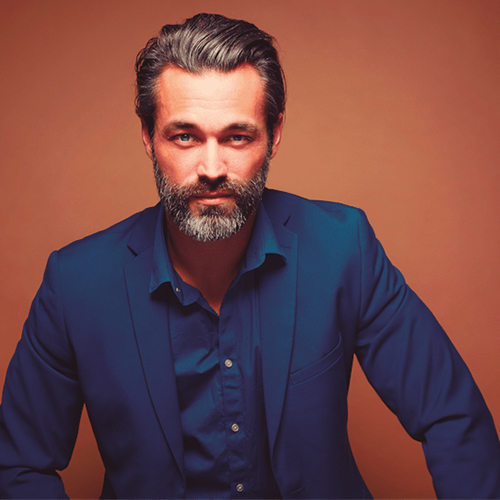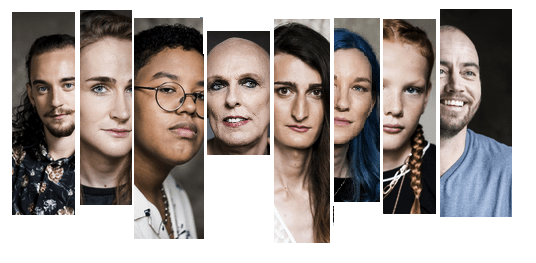
Jan Kooijman: “It’s a huge honour that our show is considered important”
One of the best-known Dutch TV programs about transgender people is Hij is een Zij (‘He is a she’), broadcast by KRO-NCRV since 2014. In each season, this six-part series follows eight young trans people over the period of a year during their transition. This show has been really important to me. I related to it a lot and it helped me determine my identity as a non-binary person. In the winter of 2019, I got the opportunity to interview Jan Kooijman for TRANS Magazine. He’s presented the program since 2016.
How did you end up presenting ‘Hij is een Zij?’
I was asked. Arie Boomsma presented the first two seasons and then left the broadcaster. KRO-NCRV wanted to continue the program and approached me. I was working for the broadcaster at the time and I was sold right away. Right now, I’ve completed two seasons and I’m working on the preparations for the next season.

What do you like about the show?
I like the documentary type of approach and the long time spent following people, which allows us to make faithful recountances. Besides, I enjoy making TV programs where I can give my curiosity free rein and that’s the case here. It’s always a challenge to take over an existing show. I wanted to add my own flavour.
And what flavour is that?
My mission is to present with humour! The subject matter is quite loaded. For each of the eight people we film, transitioning is a serious journey that often includes difficult moments. It’s my task to lighten the mood a little, to bring a smile. We don’t laugh about the people we film, on the contrary: we share moments of laughter.
For example?
Last year we accompanied Ivan and Luna to Danaë Trans-Missie, a company that makes underwear for trans people. We talked about the importance of good underwear, but also joked about the fake penises that were exhibited there. Transgenders are often familiar with such accessories, but other viewers aren’t. We show some of the products that are out there; we use humour to soften the seriousness that may surround the topic.
A transition isn’t just only drama?
Absolutely! And we try to show that in every season. Some people go through their transition with relative ease, such as Luna, shown last season with her then-boyfriend Ivan. Stories like theirs add some nuance and balance out the heavier stories.
What is this show’s impact, in your opinion?
Well, I personally never stopped to think about the ‘gender experience’. I was born as a boy and nothing could’ve been more normal to me. From a young age I learned to treat men and woman the same; to have friendships with everyone. That was thanks to the dancer community.
Many people have a one-sided, often negative image of trans people, and they can learn a lot from our show. We show that trans people are just as ‘normal’ as non-transgender people. In addition, the show provides support to those who are struggling with their gender identity. As well as those who are close to someone who is questioning their gender identity.
So, your dance career prepared you for this show?
Exactly. The world of dance has the reputation of being dominated by women and gay men; it’s true that many dancers are gay. Of course that environment made me the person I am and influenced the way I view gender and sexual orientation. I believe this background gave me some privileges. Growing up in the dance scene has enriched me as a person. I grew up in an open-minded family, which also contributed to making me receptive to anything considered ‘different’.
And how do you see your role as show host?
I see it as my job to reach as wide as an audience as possible. Not only those who’re already familiar with the topic, but also those who don’t know much about it yet. That’s why I sometimes ask questions that your ‘average’ Joe Bloggs at home are also asking themselves. So, I need to explain certain topics or terms that insiders already know sometimes. That’s part of the job.
How does the transgender community react to your show?
We sometimes get criticism for the questions we ask or terminology that we use. We try to take this into account but, as I said before, we really can’t forget about viewers who don’t know as much. We want to teach those viewers something in an accessible way. Sometimes that means using a perspective that misses nuance for those who are in the trans scene. Nevertheless, I believe we always stay respectful of the topic and the participants.
Why do you only show young people in transition?
The world of television tends to think in terms of target groups and NPO 3 is seen as a network aimed at young people. I personally think we don’t really need to maintain the distinction between target groups as strictly. Viewers don’t pay attention if a show is their target group anymore. From the very beginning I wished to feature an older participant. Luckily the broadcaster has dared to take me up on that. I was interested in following the transition of someone who’s over fifty. Someone with a different experience and has met more resistance. I can reveal: we’re finally doing it! We’re going to film someone who is not just older, but also a parent. I’m really pleased; because of the diversity that this allows us to showcase.
Why doesn’t Hij is een Zij pay any attention to trans people who have not medically transitioned?
Well, we could do that some time. There are indeed plenty of trans people who don’t go down the medical path. Such a treatment doesn’t necessarily determine one’s identity. You can feel like a man or a woman or something else, but you don’t need me to explain that to you. People decide for themselves how they express that. That much has become clear to me while making the show.
Have you, as a parent, become more conscious of how gendered the world is?
Yes, it’s striking how this gender-guided society works. But I have to say that some gender aspects are sometimes deeply rooted in people, no matter how young they are. My partner and I are raising our children as progressively as possible. They seem to go for stereotypically gendered things and behaviour anyway, apparently of their own accord. As a parent, I do try to steer my children; but I’ve noticed they have their own gender specific behaviour. At the same time, you see that more and more children deal more easily with gender. In our show, some kids already say in primary school that they feel like a boy rather than a girl, or the other way round. Then you see how their classmates react to that in a very relaxed way: “Okay! Are we going to eat a peanut butter sandwich now?”
How does that behaviour change so quickly?
It’s learned behaviour. You see the same mechanism in action with something like racism, it works the same way. You only learn it when you’re older, from people around you. I think young children really deal well with kids who are a bit different, but at a certain age there’s a turning point. Things like group pressure start kicking in and it becomes important who you’re with and who you are yourself. Your own identity becomes more essential and that makes it more difficult to diverge from the norm.
There is a similar norm in the trans community. I often get judged for being non-binary. So it was a huge relief to see Mik in the last two seasons of your show.
I understand! Mik is agender, they don’t feel like a man or a woman. We want to pursue this theme in the upcoming season. We’re going to follow someone else who doesn’t identify as a man or a woman and who would like an X in their passport. The gender scene is one that is always moving and progressing and it’s relevant to reflect that in the show. People at NPO 3 consider Hij is een Zij to be an important show. I was told this recently and it’s a huge honour.

